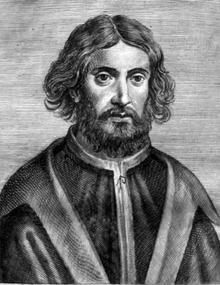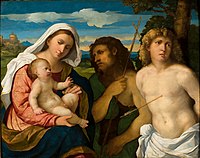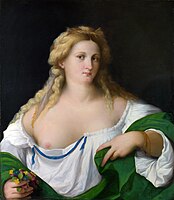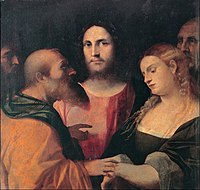Palma Vecchio
Palma Vecchio | |
|---|---|
 Imaginative portrait, c. 1648 | |
| Born | Jacomo Nigretti de Lavalle[citation needed] c. 1480 |
| Died | 30 June 1528 (aged 47–48) Venice, Republic of Venice |
| Nationality | Venetian |
| Known for | Painting |
| Movement | High Renaissance |

Palma Vecchio (c. 1480 – 30 July 1528), born Jacopo Palma,[
Life
Palma was born at
He painted the new pastoral mythologies and half-length portraits, often of idealized beauties who, then as now, were enticingly suspected of being portraits of Venice's famous courtesans. He also painted religious pieces, in particular developing the sacra conversazione (the Virgin and Child with a group of saints and perhaps donors) in a horizontal form with a landscape background. In other, secular, groups something seems to occurring between the figures, though exactly what is unclear. All these types of painting were patronized by wealthy Venetians for their homes.[4]
He also painted traditional vertical altarpieces for churches inside Venice and around the Venetian territories on the mainland such as the Presentation of the Virgin Altarpiece now in Serina. However, he was not commissioned to paint a main altar in Venice until 1525, at Sant'Elena, Venice (now Brera, Milan). He was quick to absorb influences from other parts of Italy, sometimes copying poses from Michelangelo, and taking influence from Central Italy from about 1515 into the 1520's.[2]
Palma's mature work from the 1520's shows a "
Works

His paintings frequently feature his (so-called) daughter Violante, of whom Titian was said to be enamoured. Famous works by Palma include a composition of six paintings in the Venetian church of
Other leading examples are: the Last Supper in the
It has recently been realized that Titian completed a sacra conversazione by Palma, probably after his death; he had probably done the same for Giorgione after his death. He overpainted two of the figures, and made changes to the background. It is now in the Gallerie dell'Accademia in Venice.[8]
Gallery
-
Portrait of a Poet, c. 1516
-
Young Woman in Profile, c. 1512–1514
-
Nymph in a Landscape, c. 1518–1520
-
Young Woman in a Blue Dress, with Fan, 1512–1514
-
Allegory, by 1515, Philadelphia Museum of Art
-
Assumption of the Virgin, a large altarpiece, 1512-1514.
-
The Raising of Lazarus, c. 1514
-
Sacra Conversazione, 1516–1518
-
La Bella, 1518–1520
-
A Blonde Woman, c. 1520
-
Salvator Mundi, c. 1518–1522
-
An unusually explicit Portrait of a Courtesan, 1520
-
Madonna and Child with Saint John the Baptist and Mary Magdalene, 1520–1522
-
St. Barbara polyptych, 1523–24, Santa Maria Formosa, Venice
-
Woman with a breast uncovered, 1525
-
Adoration of the Magi with Saint Helena, 1525–1526
-
Judith, 1525–1528
-
Christ and the Woman Taken in Adultery, 1525–1528
Notes
- ^ a b Freedberg, 160
- ^ a b c d e Rylands
- ^ Rylands; Freedberg, 160-163, 323; Steer, 103
- ^ Rylands; Steer, 101-103; Freedberg, 160-165; RC, 212-213; Jaffé, 41
- ^ Freedberg, 337
- ^ Freedberg, 160-165, 334-337
- ^ Philip Rylands in Jane Martineau (ed), The Genius of Venice, 1500–1600, pp. 197-198, 1983, Royal Academy of Arts, London.
- ^ Jaffé, 114, 116
- ^ Steer, 114-116
References
- ISBN 0300055870
- Jaffé, David (ed), Titian, The National Gallery Company/Yale, London 2003, ISBN 1 857099036
- "RC", Lucy Whitaker, Martin Clayton, The Art of Italy in the Royal Collection; Renaissance and Baroque, Royal Collection Publications, 2007, ISBN 9781902163291
- Rylands, Philip, "Palma." Grove Art Online. Oxford Art Online. Oxford University Press. Web. 26 February 2017. subscription required
- ISBN 0500201013
- This article incorporates text from a publication now in the public domain: Rossetti, William Michael (1911). "Palma, Jacopo". Encyclopædia Britannica. Vol. 20 (11th ed.). pp. 642–643.
Further reading
![]() Media related to Paintings by Palma il Vecchio at Wikimedia Commons
Media related to Paintings by Palma il Vecchio at Wikimedia Commons
- Rylands, Philip, Palma Vecchio, 1988, Cambridge, the standard monograph in English






![The Bravo, an example of a painting often attributed to Titian or Giorgione, but also to Palma.[9]](http://upload.wikimedia.org/wikipedia/commons/thumb/8/82/Tiziano%2C_i_bravi.jpg/172px-Tiziano%2C_i_bravi.jpg)













